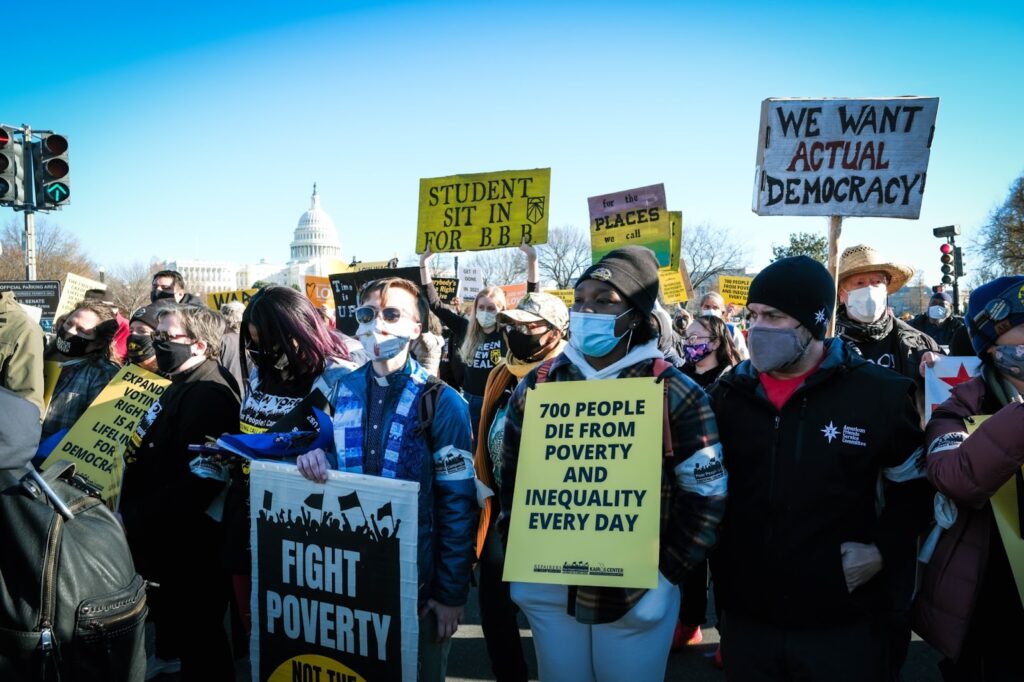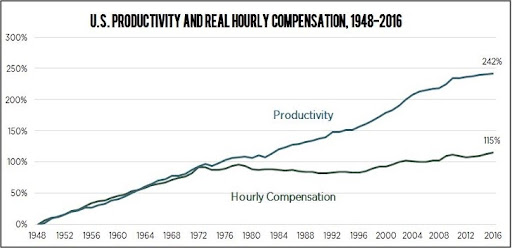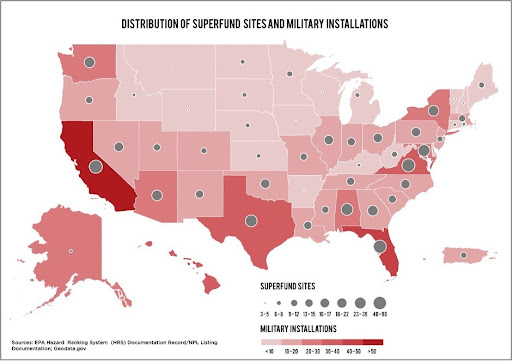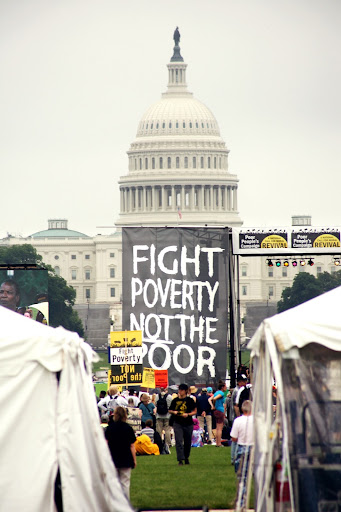
This month, Oxfam released its annual report on global inequality, Inequality Kills. Facilitated by structural and systemic policy and political choices that favor the wealthy, the paper found that extreme inequality contributes to at least 21,300 deaths across the world every single day.
Despite its great wealth and role in contributing to this inequality, the U.S. is not immune to these consequences. A 2011 study from the Mailman School of Public Health showed that 250,000 die from poverty and inequality every year in this country. That’s about 700 deaths a day.
This inequality is not new. Indeed, in his 1967 Beyond Vietnam speech, Rev. Dr. Martin Luther King, Jr., called out the glaring contrast between wealth and poverty. He saw that the war on poverty could not continue, let alone be won, so long as the war in Vietnam was escalating. The last year of his life was dedicated to uniting all the poor, across race, to build a Poor People’s Campaign: his prescription to address the interlocking injustices of poverty, racism and militarism.
Fifty years later, the Poor People’s Campaign: A National Call for Moral Revival, together with the Kairos Center, Repairers of the Breach and the Institute for Policy Studies, released the Souls of Poor Folk report, a “moral audit” on how far we had come on inequality and the triple evils that occupied King’s last years. This policy briefing revisits those findings – and updates them – to show how much we need a movement of the poor today.
A Season of Moral Action
In the summer of 2018, the Poor People’s Campaign: A National Call for Moral Revival launched its first season of nonviolent moral fusion direct action. From Mother’s Day to the Summer Solstice, the Campaign organized the largest wave of civil disobedience that the country had seen in the 21st century: 6 weeks of actions across forty states. In the course of forty days, more than 5000 people presented themselves for non-violence civil disobedience in over 200 actions.
Every week was organized around a different theme: poverty, housing and welfare; attacks on immigrants, indigenous people and democracy; the right to health and a healthy environment; living wages and adequate incomes; and the war economy. The season culminated with thousands of people in the nation’s capitol on June 23. Together, we witnessed a movement that was beginning to organize the frustrations and hope of the 140 million into a power that few of us had ever experienced. As Linda Everett from Indiana described, “As I marched, I surprised myself when I realized I had begun to cry!!!! I thought about my elders marching in the ‘60s, who were met with firehouses, dogs and cruel policemen, not to mention the blood thirsty crowd. I marched for ALL the points on our agenda and I marched for my people that couldn’t, as well as those THAT DID!”
The Souls of Poor Folk
The themes of the season of action were developed through years of reconnaissance, organizing and research and consolidated in the Souls of Poor Folk report. This “moral audit” of the nation traced the systemic and structural policy decisions that had shaped our lives, including the six findings below. (Unless otherwise noted, all graphics can be found in the Souls of Poor Folk report with citations.)
1. Polarization of wealth and poverty: Over the past 50 years, there has been a sharp disconnect between productivity and wages, with the gains of our economy going to fewer and fewer hands.

In 2018, three men had the same amount of wealth as half of the U.S. population or 160 million people, while 140 million people were poor or one living just one emergency above the poverty line.
Importantly, the bulk of the richest Americans’ wealth came from different – and more lucrative – asset sources. In 2018, America’s top 1 percent held more than half of the national wealth invested in stocks and mutual funds; the top 10 percent held over 93 percent of these assets. Meanwhile, the bottom 90 percent held most of their wealth in housing, the asset category that took the biggest hit during the Great Recession. They also held more than 70 percent of debt. In fact, nearly one in five households had zero or negative net worth, meaning they owed more than they owned.
2. On voter suppression and attacks on democracy: From 2010 to 2018, about two dozen states had passed voter suppression laws that severely restricted the participation of poor, Black, Latino and Indigenous people in elections. By 2016, 14 states had new voting restrictions in place before the presidential election. (Three of these states – Ohio, Virginia, and Wisconsin – flipped their party outcomes in the presidential elections from 2012 to 2016.) At the same time, 13 percent of all Black men had been denied the right to vote through felony disenfranchisement.
Post-election attacks on democracy continued through practices like emergency financial management, whereby elected officials appointed financial managers who have broad-based authority to dismiss elected officials, scrap labor contracts, sell public assets and impose new taxes, without any accountability. Flint was under emergency management when the city decided to change its water source. To save a few million dollars, the city’s 99,000 residents were poisoned.
As Flint resident and organizer Claire McClinton said, “they could not take our water away without taking our democracy first.”
3. On wages and incomes: In 2018, the federal minimum wage had stagnated at $7.25 per hour and over 50 million workers were earning less than $15 per hour, with marked differences by race and gender. These poverty wages had prompted new forms of organizing, including the Fight for $15, which had been able to secure higher wages in numerous states and cities. In response to many of these local victories, 25 states had also enacted laws to preempt cities from passing higher minimum wages.
Also in 2018, the union participation rate was less than half of what it was in 1968 and “right to work” laws had been passed in 28 states.
4. On public support and resources for basic needs: Even though low-wage work was on the rise, government assistance programs were on the decline, especially programs that targeted the poor.
The greatest reduction in poverty programs came with the passage of welfare reform in 1996. After welfare reform, the percentage of families eligible for assistance who were enrolled in the program was cut from 68 percent under AFDC to just 23 percent with TANF. Those who were enrolled were both receiving fewer benefits and subject to unrealistic work requirements that contributed to the expansion of low-wage work.
Federal assistance and subsidized housing had also been cut year after year since the 1970s. The affordable housing stock has been slashed and, as of 2018, only one in four eligible renters was receiving housing assistance.
Federal assistance for local water utilities had fallen 74 percent since its peak in 1977. Municipalities had to forego making necessary improvements to their pipe and water infrastructure. Many privatized their water, resulting in higher rates for users. This precipitated massive water shut offs across the country. As of 2018, nearly 14 million households could not afford their water and nearly three times more were predicted to face the same condition within five years.
Finally, while the Affordable Care Act led to major gains in health insurance coverage (most of which was due to the expansion of Medicaid), millions of people remained uninsured and the costs of health care were making it unaffordable for those who had coverage. In 2016, more than two out of five adults with health insurance still struggled to make their deductible payments, nearly three in four had to cut back on their needs to pay their medical bills, and the number one cause of personal bankruptcy was medical debt. This left 87 million people either uninsured or underinsured, unable to access health care even if they were enrolled.
5. On fossil fuels and climate crisis: In 2018, U.S. was the largest producer of oil and natural gas in the world, mainly due to the expansion of fracking.

This came at the immense cost of leakages, spills and ruptures that released toxic chemicals into the land, water and air, much of which was concentrated in poor and low-income communities and Native and Indigenous lands. While there had been over 2400 spills from offshore drilling operations since the 1960s, one single event – the BP spill off the coast of Louisiana in 2010 – was responsible for 4.9 million of the 5.2 million barrels of oil that had been released into our waters since 1968. Coal ash ponds and highly toxic “superfund” sites contributed to this dangerous pollution.
Despite knowing the damage and risks from fossil fuel use, political leadership continued to drag its feet on implementing solutions. Only a system rooted in inequality would allow a wealthy elite to profit from a business model that threatens the future of humanity.
6. On militarism and more: In the fifty years since 1968, military spending had nearly doubled, from $365 billion to $668 billion. The U.S. was fighting wars in multiple countries and special forces were deployed in 149 countries. This expansion meant that, in 2018, we were spending 53 cents of every discretionary dollar on the military and only 15 cents on anti-poverty programs.
These military interventions have caused a staggering number of civilian deaths in poor countries, taken a toll on U.S. troops and personnel – with an average of 20 veteran suicides every day, and are destroying the planet. The Department of Defense was responsible for 72 percent of U.S. greenhouse gas emissions in 2016.
Militarism abroad went hand in hand with the militarization of U.S. borders and the criminalization of the poor more broadly. Since 1976, federal spending on immigration, deportation and border police increased more than eightfold and deportations increased tenfold. As early as 2017, family separation and child detention were being reported by border communities. Local police departments have also been equipped by the federal government with hundreds of millions of dollars of military equipment like tanks and grenade launchers.
Federal spending on prisons has grown similarly, with a tenfold increase in spending and nearly eight times as many inmates. There has been a national increase in pretrial detention, most of which is concentrated in rural counties, whose increase in pretrial detention rates is six times the national average. In fact, by the Department of Justice’s own admission, 95 percent of the growth in the incarcerated population since 2000 are the number of people who cannot make bail. They are presumed innocent, but too poor to be free.
***
The Souls of Poor Folk made clear that the challenge we face is not a question of resources – or working harder, complaining less and praying more – but national priorities. As more and more of our wealth flows into the pockets of a small, but powerful, few, the scarcity we face is one of political will.
This is true across party lines. Productivity separated from wages during Richard Nixon’s term and this great divide continued across every administration and Congress since that time. The racist trope of the “welfare queen” propagated by Ronald Reagan was institutionalized under Bill Clinton through welfare reform in 1996. The wars in the Middle East began by George H.W. Bush were continued by his son, Barack Obama and Donald Trump.
Four Years On, Four Years Worse
As indicated below, most if not all, of the conditions we reported on in the Souls of Poor Folk have become worse since 2018. Some of this was hastened by the pandemic, however, many of the conditions that gave rise to the pandemic – and the devastation it wrought – were rooted in decades of policy decisions that preceded it. (For more on this point, read the article Moral Policy = Good Economics, co-authored with the Economic Policy Institute.)
1. Polarization of wealth and poverty: During the worst economic and public health crises in decades, U.S. billionaires added over $2 trillion to their existing wealth. According to Oxfam, the increase in Bezos’ fortune alone during the pandemic could pay for everyone on earth to be safely vaccinated. U.S. corporate wealth also went up by over $2.5 trillion. Instead of using these gains to build up their workforce, corporations were repurchasing their shares to inflate shareholders’ wealth by $234 billion.
The wealthy have been able to effectively protect their interests and push back against a full “Build Back Better” agenda, including against wage increases, paid leave, immigration justice and higher taxes on their wealth and gains. They have also secured shorter quarantine and isolation requirements. (Most recently, the Supreme Court ruled against mandated vaccine, testing and mask requirements for large employers – but not smaller ones.)
It is estimated that without pandemic-era programs that benefit poor and low-income households – stimulus payments, expanded unemployment insurance and more – the number of poor and low-income people would have grown from 140 million to well over 150 million. Now that most of these programs have ended, we can expect a backslide into greater poverty.
2. On voter suppression and attacks on democracy: The rolling coup that began more than one decade ago gained dangerous ground in 2021. In 2021 alone, 19 states passed more than 30 voter suppression laws, which may impact as many as 55 million eligible voters.
At the federal level, every Republican member of Congress and a small number of Democrats have voted down protections for voting rights and democracy, most recently with the Freedom to Vote: John Lewis Voting Rights Advancement Act. And, the Supreme Court further weakened the Voting Rights Act when it reinstated two Arizona laws and narrowed the scope of Section 2 of the landmark bill.
3. On wages and income: As of January 2022, 21 states raised their minimum wage. The wage increases range from $8.75 (West Virginia) to $15 (California). However, many of these wage increases have been disintegrated with the rise in inflation, and 20 states still use the federal minimum wage of $7.25. Half of these states are in the south.
4. On federal programs for basic needs: During the pandemic, stimulus checks, expanded unemployment insurance, protections against eviction and foreclosure, pushing back payments on student loans and the expanded child tax credit (CTC) eased the economic burden facing poor and low-income households.
The CTC seemed to offer true potential in redirecting welfare policy: it raised benefits, was expanded to reach poor families and the benefits were paid out in monthly installments, without imposing any work requirements or other bureaucratic hurdles. Those installments reached 61 million children in 36 million households. They kept over 3.7 million children above the poverty line. Indeed, more than 90% of low-income households spent their CTC payments meeting basic needs like food, housing, utility payments, clothes and education.
Nearly all of these programs have now ended. Pandemic unemployment benefits were cut off for 7.5 million workers on Labor Day weekend. This was the largest cutoff of unemployment benefits in U.S. history. Around the same time, the Supreme Court also lifted the moratorium on evictions, even though millions of people are at risk of becoming homeless and 76 percent of low-income renters who need federal assistance do not receive it.
Likewise, the last payment of the CTC went out the week before Christmas, with a revival of the same arguments that were used to justify welfare reform in 1996. It is unclear that this program will be reinstated or, if it is, whether it will have the same reach and impact. What is clear is that now that these payments have ended, the gains against child poverty will likely recede.
Finally, the biggest expansion in healthcare that has taken place in the past few years has been through the 10 million people who enrolled in Medicaid during the pandemic. Medicaid covers more than 80 million people with free or low-cost health care. This was facilitated by states that took action, with the encouragement of additional federal funding made available through the American Rescue Plan Act, and people who could not afford to pay for health care enrolling in their state plans. However, there was no federal action taken to guarantee that everyone had health coverage during the pandemic.

This map from the Kaiser Family Foundation shows the states that have still not expanded Medicaid, many of which continue to see more deaths than other parts of the country.
5. On the climate crisis: In 2021 alone, the U.S. experienced 20 weather and climate disasters from drought, flooding, super storms, cyclones, wildfires and winter storms, each of which caused deaths, displacement and massive economic losses. Average global surface temperature hit the hottest since being recorded in 1880, Artic ice shelves were melting and the Intergovernmental Panel on Climate Change concluded that some of the climate impacts of human activity were now inevitable and irreversible.
Although, according to Oxfam, the wealthiest billionaires emit 8000 times more carbon than the billion poorest people, poor and low-income communities are hit first and worst by these crises. The UNHCR estimates that more than 20 million people are displaced from climate disasters every year. In August 2021, Hurricane Ida ripped through the Gulf Coast and destroyed the community of St. James Parish. St. James falls in the 85-mile stretch known as Cancer Alley, where more than 200 petrochemical plants have been polluting the climate and residents have the highest cancer rates in the nation. Ida was followed by Tropical Storm Nicholas. Sharon Lavigne, a life-time resident who has been organizing her community against yet another power plant, was among those who lost their homes and everything they had.
6. On militarism and more: In December 2021, President Biden approved the $768 billion National Defense Authorization Act, about $20 billion more than the Pentagon requested. This war budget was four times as much as the Build Back Better Act (BBBA) and passed with bi-partisan support. Meanwhile, the BBBA remains stalled in the Senate, with its detractors saying they can’t justify its cost.
In our neighborhoods, and despite widespread protests over police killings, in 2021 police departments began to be “refunded.” Tragically, the number of police killings did not change significantly.
No Choice But to Push
Again, we know the challenges we face today are not due to a shortage of resources. As Oxfam wrote, “There is only a shortage of courage to tackle inequality, and the wealth and might of the rich and the powerful, and a shortage of the imagination needed to break free from the failed, narrow straitjacket of extreme neoliberalism.”
In 2021, the PPC:NCMR recognized the crises at hand and called for the courage and imagination to address these interlocking injustices together. Through 14 weeks of Moral Mondays and a six-month season of non-violent moral fusion direct action, we held fast to this approach. When Congress started picking apart the issues – first infrastructure, then Build Back Better, then voting rights – we insisted that these three “infrastructures” had to be addressed together.
In 1967, Dr. King realized that it would take a movement led by those most impacted by these immoral policies and unjust laws to put this country back on track. He said, “The dispossessed of this nation — the poor, both white and Negro — live in a cruelly unjust society. They must organize a revolution against the injustice, not against the lives of the persons who are their fellow citizens, but against the structures through which the society is refusing to take means which have been called for, and which are at hand, to lift the load of poverty…if they can be helped to take action together, they will do so with a freedom and a power that will be a new and unsettling force in our complacent national life.”
Today, we need no less.
As Nic Smith from Virginia said back in 2018, “I’m poor, I’m white, and I’m here. This hillbilly is joining other poor people of all colors, all sexualities, all religions, to start the Poor People’s Campaign: A National Call for Moral Revival. Our backs are against the wall and we have no choice but to push.”
